HONDA CR-Z 2011 1.G Owners Manual
Manufacturer: HONDA, Model Year: 2011, Model line: CR-Z, Model: HONDA CR-Z 2011 1.GPages: 333, PDF Size: 9.97 MB
Page 311 of 333
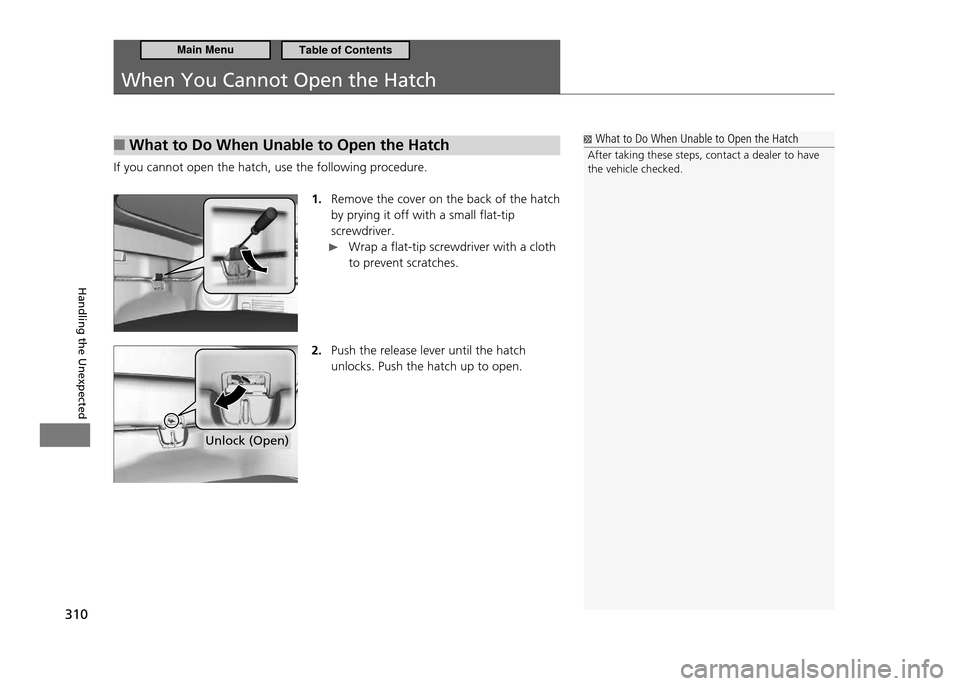
310
Handling the Unexpected
When You Cannot Open the Hatch
What to Do When Unable to Open the Hatch
■
If you cannot open the hatch, use the following procedure.
1. Remove the cover on the back of the hatch by prying it off with a small flat-tip screwdriver.
Wrap a flat-tip screwdriver with a cloth
to prevent scratches.
2. Push the release lever until the hatch unlocks. Push the hatch up to open.
Unlock (Open)
What to Do When Unable to Open the Hatch
After taking these steps, contact a dealer to have the vehicle checked.
Main MenuTable of Contents
Page 312 of 333
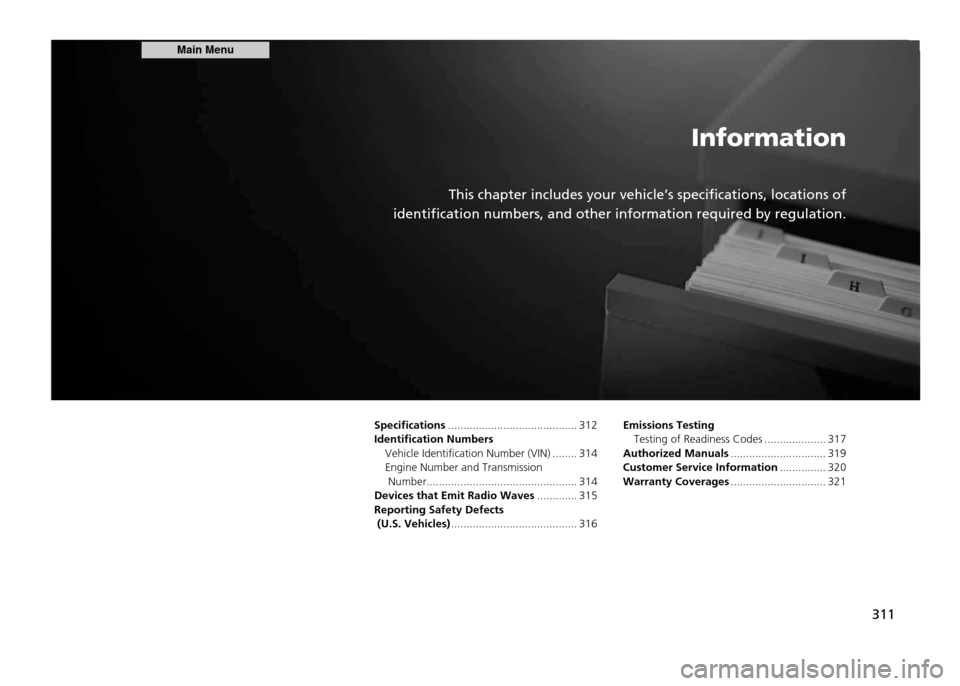
Information
This chapter includes your vehicle’s specifications, locations of
identification numbers, and other information required by regulation.
311
Specifications
.......................................... 312
Identification Numbers Vehicle Identification Number (VIN) ........ 314 Engine Number and Transmission
Number ................................................. 314
Devices that Emit Radio Waves ............. 315
Reporting Safety Defects (U.S. Vehicles) ......................................... 316 Emissions Testing
Testing of Readiness Codes .................... 317
Authorized Manuals ............................... 319
Customer Service Information ............... 320
Warranty Coverages ............................... 321
Main Menu
Page 313 of 333
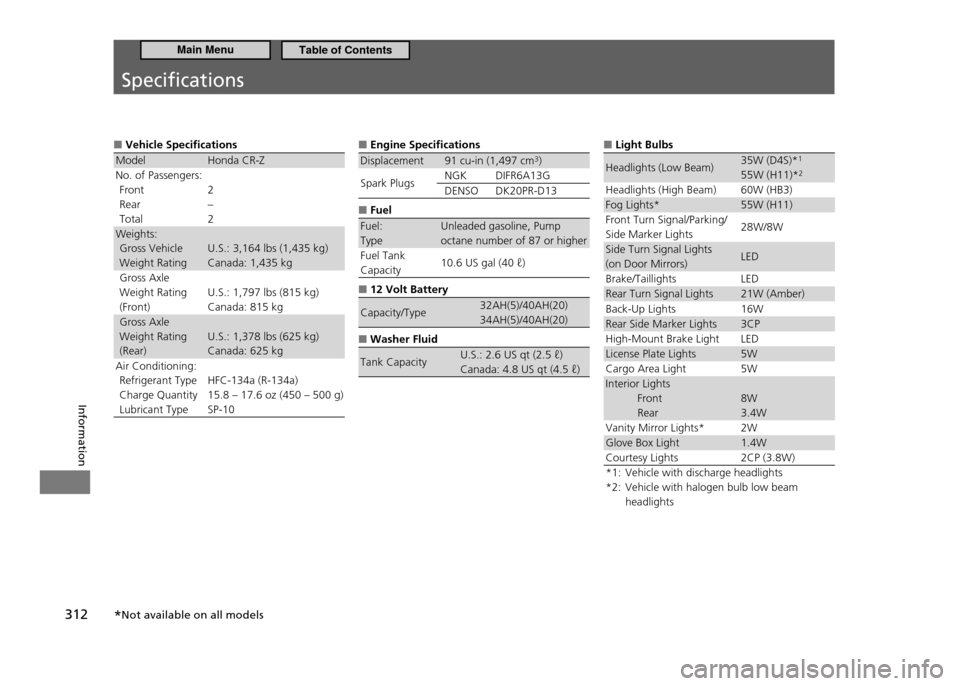
312
Information
Speciications
Vehicle Specifications
■
Model Honda CR-Z No. of Passengers:
Front RearTotal 2–2
Weights: Gross Vehicle Weight Rating U.S.: 3,164 lbs (1,435 kg)Canada: 1,435 kg
Gross Axle Weight Rating (Front) U.S.: 1,797 lbs (815 kg)Canada: 815 kg
Gross Axle Weight Rating (Rear) U.S.: 1,378 lbs (625 kg)Canada: 625 kg
Air Conditioning: Refrigerant TypeCharge QuantityLubricant Type HFC-134a (R-134a)15.8 – 17.6 oz (450 – 500 g)SP-10
Engine Specifications
■
Displacement 91 cu-in (1,497 cm 3
)
Spark Plugs NGK DIFR6A13G
DENSO DK20PR-D13
Fuel
■
Fuel: Type Unleaded gasoline, Pump octane number of 87 or higher
Fuel Tank Capacity 10.6 US gal (40 ℓ)
12 Volt Battery
■
Capacity/Type 32AH(5)/40AH(20) 34AH(5)/40AH(20)
Washer Fluid
■
Tank Capacity U.S.: 2.6 US qt (2.5 ℓ) Canada: 4.8 US qt (4.5 ℓ)
Light Bulbs
■
Headlights (Low Beam) 35W (D4S)*
1
55W (H11)* 2
Headlights (High Beam) 60W (HB3)
Fog Lights* 55W (H11)Front Turn Signal/Parking/ Side Marker Lights 28W/8W
Side Turn Signal Lights(on Door Mirrors) LED
Brake/Taillights LED
Rear Turn Signal Lights 21W (Amber)
Back-Up Lights 16W
Rear Side Marker Lights 3CP
High-Mount Brake Light LED
License Plate Lights 5W
Cargo Area Light 5WInterior Lights
Front
Rear 8W3.4W
Vanity Mirror Lights* 2W
Glove Box Light 1.4W
Courtesy Lights 2CP (3.8W)
*1: Vehicle with discharge headlights
*2: Vehicle with halogen bulb low beam headlights
* Not available on all models
Main MenuTable of Contents
Page 314 of 333
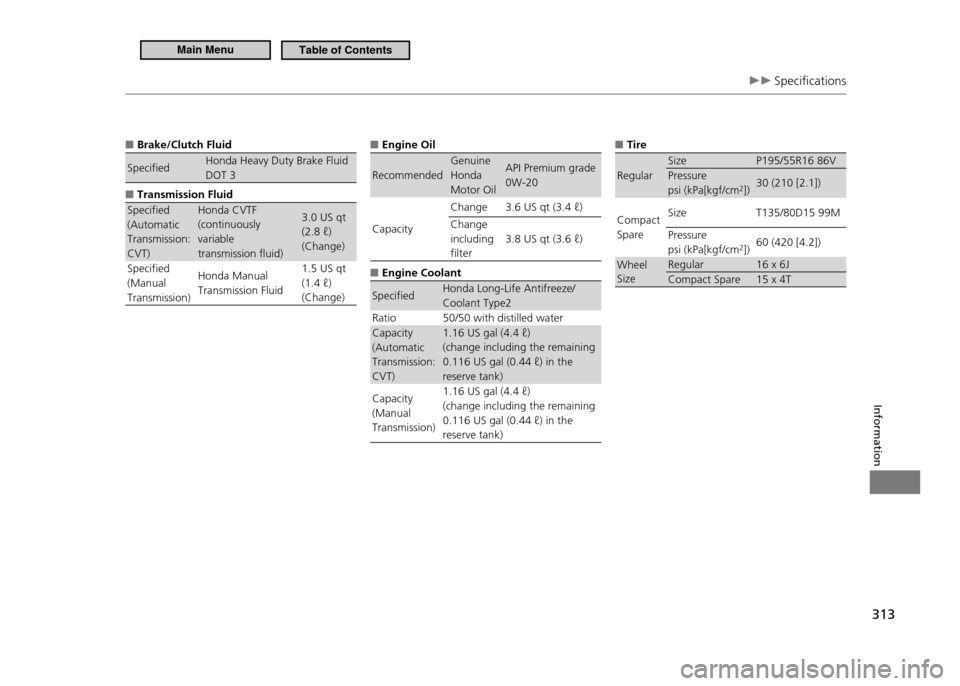
313
Information
Speciications
Brake/Clutch Fluid
■
Specified Honda Heavy Duty Brake Fluid DOT 3
Transmission Fluid
■
Specified (Automatic Transmission: CVT) Honda CVTF (continuously variable transmission fluid)
3.0 US qt (2.8 ℓ) (Change)
Specified (Manual Transmission) Honda Manual Transmission Fluid 1.5 US qt (1.4 ℓ) (Change)
Engine Oil
■
Recommended Genuine Honda Motor OilAPI Premium grade 0W-20
Capacity Change 3.6 US qt (3.4 ℓ) Change including filter
3.8 US qt (3.6 ℓ)
Engine Coolant
■
Specified Honda Long-Life Antifreeze/ Coolant Type2
Ratio 50/50 with distilled water Capacity (Automatic Transmission: CVT) 1.16 US gal (4.4 ℓ) (change including the remaining 0.116 US gal (0.44 ℓ) in the reserve tank)
Capacity (Manual Transmission) 1.16 US gal (4.4 ℓ) (change including the remaining 0.116 US gal (0.44 ℓ) in the reserve tank)
Tire
■
Regular Size P195/55R16 86V Pressure psi (kPa[kgf/cm
2
]) 30 (210 [2.1])
Compact Spare Size T135/80D15 99M Pressure psi (kPa[kgf/cm
2
]) 60 (420 [4.2])
Wheel Size Regular 16 x 6J
Compact Spare 15 x 4T
Main MenuTable of Contents
Page 315 of 333

314
Information
Identiication Numbers
Vehicle Identiication Number (VIN)
Your vehicle has a 17-digit vehicle identification number (VIN) used to register your vehicle for warranty purposes, and for licensing and insuring your vehicle. See the image below for the VIN locations. Engine Number and Transmission Number See the image below for the locations of your vehicle’s engine number and transmission number.
Vehicle I dentiica tio n N umbe r
Ve hicle I dentiica tio n N umbe r
IMA Motor Number
Engine Numb er
Certiication Label/Vehicle Identiication NumberManual Transmi ssion
Number Au tomati c Tra nsmi ssion (CVT)
Number
Main MenuTable of Contents
Page 316 of 333
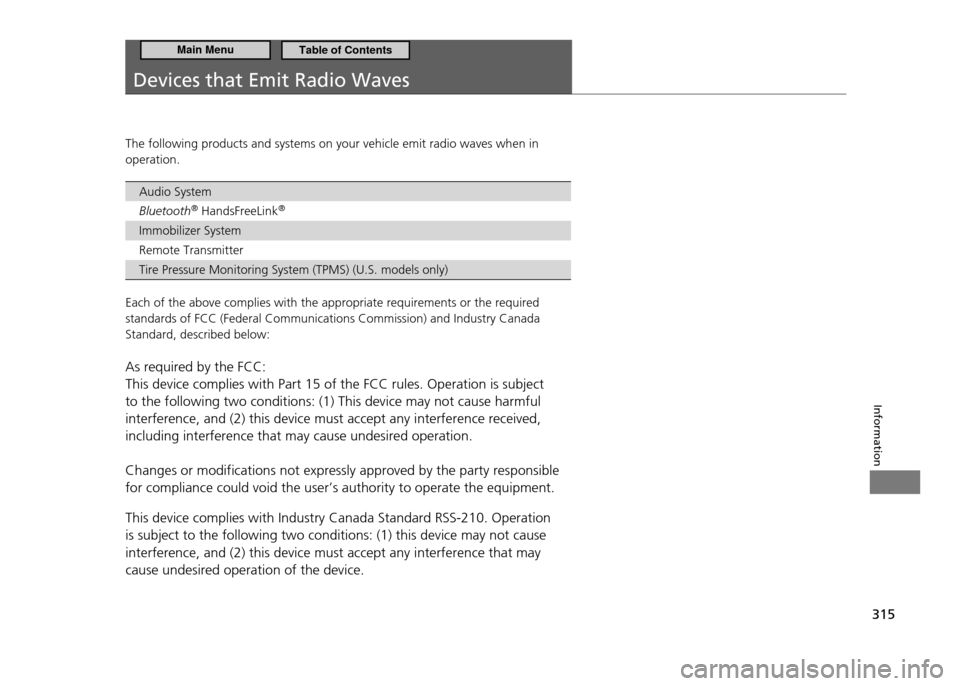
315
Information
Devices that Emit Radio Waves
The following products and systems on your vehicle emit radio waves when in operation.
Audio System Bluetooth®
HandsFreeLink ®
Immobilizer System Remote Transmitter Tire Pressure Monitoring System (TPMS) (U.S. models only)
Each of the above complies with the appropriate requirements or the required standards of FCC (Federal Communications Commission) and Industry Canada Standard, described below:
As required by the FCC: This device complies with Part 15 of the FCC rules. Operation is subject to the following two conditions: (1) This device may not cause harmful interference, and (2) this device must accept any interference received, including interference that may cause undesired operation. Changes or modifications not expressly approved by the party responsible for compliance could void the user’s authority to operate the equipment. This device complies with Industry Canada Standard RSS-210. Operation is subject to the following two conditions: (1) this device may not cause interference, and (2) this device must accept any interference that may cause undesired operation of the device.
Main MenuTable of Contents
Page 317 of 333

316
Information
Reporting Safety Defects (U.S. Vehicles)
If you believe that your vehicle has a defect which could cause a crash or could cause injury or death, you should immediately inform the National Highway Traffic Safety Administration (NHTSA) in addition to notifying American Honda Motor Co., Inc. If NHTSA receives similar complaints, it may open an investigation, and if it finds that a safety defect exists in a group of vehicles, it may order a recall and remedy campaign. However, NHTSA cannot become involved in individual problems between you, your dealer, or American Honda Motor Co., Inc. To contact NHTSA, you may call the Vehicle Safety Hotline toll-free at 1-888-327-4236 (TTY: 1-800-424-9153); go to http://www.safercar.gov; or
write to: Administrator, NHTSA, 1200 New Jersey Ave nue, SE., Washington,
DC 20590. You can also obtain other information about motor vehicle safety from http://www.safercar.gov .
Main MenuTable of Contents
Page 318 of 333
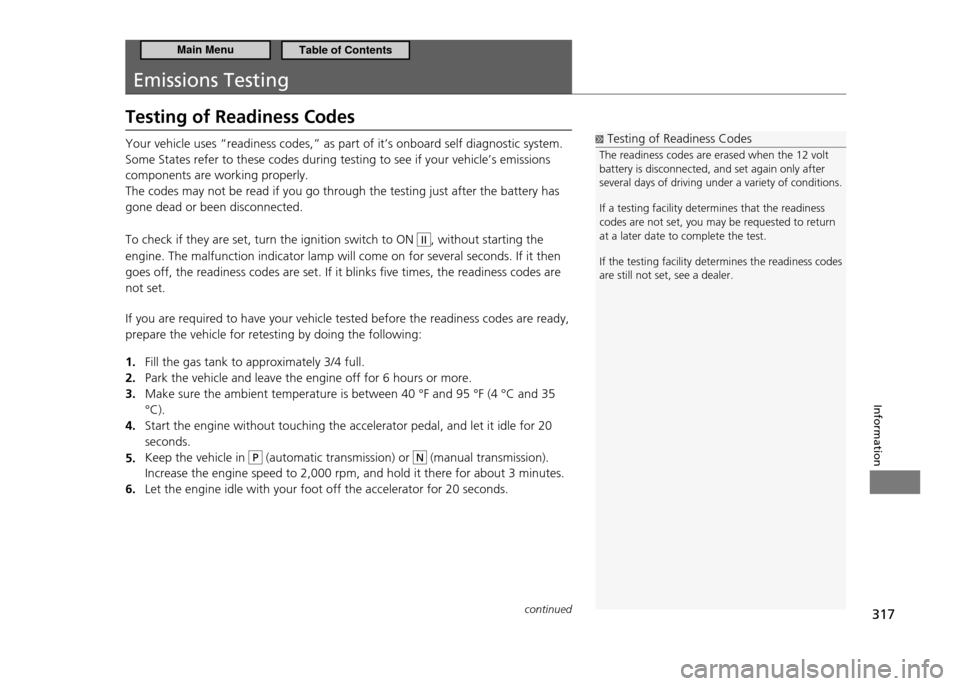
317
Information
Emissions Testing
Testing of Readiness Codes
Testing of Readiness Codes
The readiness codes are erased when the 12 volt battery is disconnected, and set again only after several days of driving under a variety of conditions. If a testing facility determines that the readiness codes are not set, you may be requested to return at a later date to complete the test.
If the testing facility determines the readiness co des
are still not set, see a dealer.
Your vehicle uses “readiness codes,” as part of it’s onboard self diagnostic system. Some States refer to these codes during testing to see if your vehicle’s emissions components are working properly. The codes may not be read if you go through the testing just after the battery has gone dead or been disconnected. To check if they are set, turn the ignition switch to ON
II, without starting the
engine. The malfunction indicator lamp will come on for several seconds. If it then goes off, the readiness codes are set. If it blinks five times, the readiness codes are not set. If you are required to have your vehicle tested before the readiness codes are ready, prepare the vehicle for retesting by doing the following:
Fill the gas tank to approximately 3/4 full.
1.
Park the vehicle and leave the engine off for 6 hours or more.
2.
Make sure the ambient temperature is between 40 °F and 95 °F (4 °C and 35
3.
°C).Start the engine without touching the accelerator pedal, and let it idle for 20
4.
seconds.Keep the vehicle in
5.
P (automatic transmission) or N (manual transmission).
Increase the engine speed to 2,000 rpm, and hold it there for about 3 minutes. Let the engine idle with your foot off the accelerator for 20 seconds.
6.
continued
Main MenuTable of Contents
Page 319 of 333
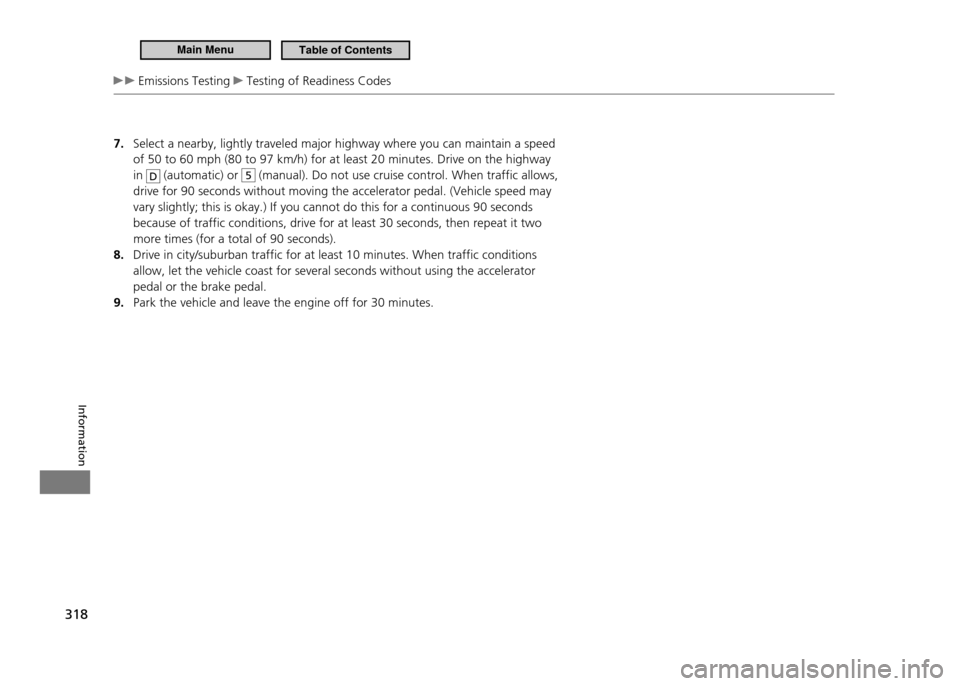
318
Information
Emissions Testing Testing of Readiness Codes
Select a nearby, lightly traveled major highway where you can maintain a speed
7.
of 50 to 60 mph (80 to 97 km/h) for at least 20 minutes. Drive on the highway in
D (automatic) or 5 (manual). Do not use cruise control. When traffic allows,
drive for 90 seconds without moving the accelerator pedal. (Vehicle speed may vary slightly; this is okay.) If you cannot do this for a continuous 90 seconds because of traffic conditions, drive for at least 30 seconds, then repeat it two more times (for a total of 90 seconds).Drive in city/suburban traffic for at least 10 minutes. When traffic conditions
8.
allow, let the vehicle coast for several seconds without using the accelerator pedal or the brake pedal.Park the vehicle and leave the engine off for 30 minutes.
9.
Main MenuTable of Contents
Page 320 of 333

319
Information
Authorized Manuals
U.S. Owners: The publications listed below can be purchased from Helm Incorporated. You can order a manual by phone at (800) 782-4356 (credit card orders only), or online at www.helminc.com.
Make an inquiry to Helm Inc. at (800) 782-4356 if you are interested in ordering other models’ or other years’ manuals.
Publication Form Number Form Description
61SZT00 2011 Honda CR-Z Service Manual
61SZT00EL 2011 Honda CR-Z Electrical Troubleshooting Manual
61SZT30 2011 Honda CR-Z Body Repair Manual
31SZT600 2011 Honda CR-Z Owner’s Manual
31SZT800 2011 Honda CR-Z Navigation System Owner’s Manual
31SZTM00 2011 Honda CR-Z Honda Service History
31SZTQ00 2011 Honda CR-Z Technology Reference Guide
HON-R Order Form for Previous Years-Indicate Year and Model Desired
Authorized Manuals
Service Manual:
Covers maintenance and recommended procedures for repair to engine and chassis components. It is written for the journeyman technician, but it is simple enough for most mechanically inclined owners to understand. Electrical Troubleshooting Manual: Complements the Service Manual by providing in-depth troubleshooting information for each electrical circuit in your vehicle. Body Repair Manual: Describes the procedures involved in the replacement of damaged body parts.
Main MenuTable of Contents